Yamaha YSP-4000 User Manual

UA
YSP-4000
Digital Sound ProjectorTM
OWNER’S MANUAL
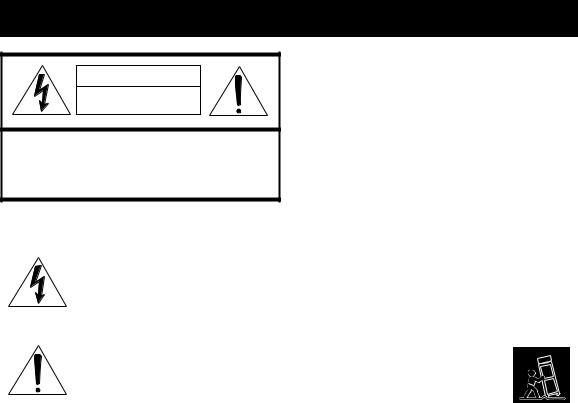
IMPORTANT SAFETY INSTRUCTIONS
CAUTION |
RISK OF ELECTRIC SHOCK |
DO NOT OPEN |
CAUTION: TO REDUCE THE RISK OF |
ELECTRIC SHOCK, DO NOT REMOVE |
COVER (OR BACK). NO USER-SERVICEABLE |
PARTS INSIDE. REFER SERVICING TO |
QUALIFIED SERVICE PERSONNEL. |
■ Explanation of Graphical Symbols
The lightning flash with arrowhead symbol, within an equilateral triangle, is intended to alert you to the presence of uninsulated “dangerous voltage” within the product’s enclosure that may be of sufficient magnitude to constitute a risk of electric shock to persons.
The exclamation point within an equilateral triangle is intended to alert you to the presence of important operating and maintenance (servicing) instructions in the literature accompanying the appliance.
1Read these instructions.
2Keep these instructions.
3Heed all warnings.
4Follow all instructions.
5Do not use this apparatus near water.
6Clean only with dry cloth.
7Do not block any ventilation openings. Install in accordance with the manufacturer’s instructions.
8Do not install near any heat sources such as radiators, heat registers, stoves, or other apparatus (including amplifiers) that produce heat.
9Do not defeat the safety purpose of the polarized or groundingtype plug. A polarized plug has two blades with one wider than the other. A grounding type plug has two blades and a third grounding prong. The wide
blade or the third prong are provided for your safety. If the provided plug does not fit into your outlet, consult an electrician for replacement of the obsolete outlet.
10Protect the power cord from being walked on or pinched particularly at plugs, convenience receptacles, and the point where they exit from the apparatus.
11Only use attachments/accessories specified by the manufacturer.
12Use only with the cart, stand, tripod, bracket,
or table specified by the manufacturer, or sold with the apparatus. When a cart is used, use caution when moving the cart/apparatus combination to avoid injury from tip-over.
13Unplug this apparatus during lightning
storms or when unused for long periods of time.
14Refer all servicing to qualified service personnel. Servicing is required when the apparatus has been damaged in any way, such as power supply cable or plug is damaged, liquid has been spilled or objects have fallen into the apparatus, the apparatus has been exposed to rain or moisture, does not operate normally, or has been dropped.
i En

IMPORTANT SAFETY INSTRUCTIONS
FCC INFORMATION (for US customers)
1.IMPORTANT NOTICE: DO NOT MODIFY THIS UNIT!
This product, when installed as indicated in the instructions contained in this manual, meets FCC requirements. Modifications not expressly approved by Yamaha may void your authority, granted by the FCC, to use the product.
2.IMPORTANT:
When connecting this product to accessories and/or another product use only high quality shielded cables. Cable/s supplied with this product MUST be used. Follow all installation instructions. Failure to follow instructions could void your FCC authorization to use this product in the USA.
3.NOTE:
This product has been tested and found to comply with the requirements listed in FCC Regulations, Part 15 for Class “B” digital devices. Compliance with these requirements provides a reasonable level of assurance that your use of this product in a residential environment will not result in harmful interference with other electronic devices.
This equipment generates/uses radio frequencies and, if not installed and used according to the instructions found in the users manual, may cause interference harmful to the operation of other electronic devices.
Compliance with FCC regulations does not guarantee that interference will not occur in all installations. If this product is found to be the source of interference, which can be determined by turning the unit “OFF” and “ON”, please try to eliminate the problem by using one of the following measures:
Relocate either this product or the device that is being affected by the interference.
Utilize power outlets that are on different branch (circuit breaker or fuse) circuits or install AC line filter/s.
In the case of radio or TV interference, relocate/reorient the antenna. If the antenna lead-in is 300 ohm ribbon lead, change the lead-in to coaxial type cable.
If these corrective measures do not produce satisfactory results, please contact the local retailer authorized to distribute this type of product. If you can not locate the appropriate retailer, please contact Yamaha Electronics Corp., U.S.A. 6660 Orangethorpe Ave, Buena Park, CA 90620.
The above statements apply ONLY to those products distributed by Yamaha Corporation of America or its subsidiaries.
We Want You Listening For A Lifetime
Yamaha and the Electronic Industries Association’s Consumer Electronics Group want you to get the most out of your equipment by playing it at a safe level. One that lets the sound come through loud and clear without annoying
blaring or distortion – and, most importantly, without affecting your sensitive hearing.
Since hearing damage from loud sounds is often undetectable until it is too late, Yamaha and the Electronic Industries Association’s Consumer Electronics Group recommend you to avoid prolonged exposure from excessive volume levels.
ii En

Caution: Read this before operating this unit.
1To assure the finest performance, please read this manual carefully. Keep it in a safe place for future reference.
2Install this sound system in a well ventilated, cool, dry, clean place with at least 5 cm (2 in) of space above (or below) this unit – away from direct sunlight, heat sources, vibration, dust, moisture, and/or cold.
3Locate this unit away from other electrical appliances, motors, or transformers to avoid humming sounds.
4Do not expose this unit to sudden temperature changes from cold to hot, and do not locate this unit in an environment with high humidity (i.e. a room with a humidifier) to prevent condensation inside this unit, which may cause an electrical shock, fire, damage to this unit, and/or personal injury.
5Avoid installing this unit where foreign object may fall onto this unit and/or this unit may be exposed to liquid dripping or splashing. On the top of this unit, do not place:
–Other components, as they may cause damage and/or discoloration on the surface of this unit.
–Burning objects (i.e. candles), as they may cause fire, damage to this unit, and/or personal injury.
–Containers with liquid in them, as they may fall and liquid may cause electrical shock to the user and/or damage to this unit.
6Do not cover this unit with a newspaper, tablecloth, curtain, etc. in order not to obstruct heat radiation. If the temperature inside this unit rises, it may cause fire, damage to this unit, and/or personal injury.
7Do not plug in this unit to a wall outlet until all connections are complete.
8Do not operate this unit upside-down. It may overheat, possibly causing damage.
9Do not use force on switches, knobs and/or cords.
10When disconnecting the power supply cable from the wall outlet, grasp the plug; do not pull the cable.
11Do not clean this unit with chemical solvents; this might damage the finish. Use a clean, dry cloth.
12Only voltage specified on this unit must be used. Using this unit with a higher voltage than specified is dangerous and may cause fire, damage to this unit, and/or personal injury. Yamaha will not be held responsible for any damage resulting from use of this unit with a voltage other than specified.
13To prevent damage by lightning, keep the power supply cable disconnected from a wall outlet or this unit during a lightning storm.
14Do not attempt to modify or fix this unit. Contact qualified Yamaha service personnel when any service is needed. The cabinet should never be opened for any reasons.
15When not planning to use this unit for long periods of time (i.e. vacation), disconnect the power supply cable from the wall outlet.
16Be sure to read the “Troubleshooting” section on common operating errors before concluding that this unit is faulty.
17Before moving this unit, press STANDBY/ON to set this unit in standby mode, and disconnect the power supply cable from the wall outlet.
18Condensation will form when the surrounding temperature changes suddenly. Disconnect the power supply cable from the outlet, then leave the unit alone.
19When using the unit for a long time, the unit may become warm. Turn the power off, then leave the unit alone for cooling.
20Install this unit near the AC outlet and where the AC power plug can be reached easily.
21The batteries shall not be exposed to excessive heat such as sunshine, fire or the like.
WARNING
TO REDUCE THE RISK OF FIRE OR ELECTRIC SHOCK, DO NOT EXPOSE THIS UNIT TO RAIN OR MOISTURE.
WARNING
THE POWER SUPPLY CABLE OF THIS UNIT MUST BE CONNECTED TO THE MAIN SOCKET OUTLET VIA A PROTECTIVE EARTHING CONNECTION.
This unit is not disconnected from the AC power source as long as it is connected to the AC wall outlet, even if this unit itself is turned off by STANDBY/ON. This state is called the standby mode. In this state, this unit is designed to consume a very small quantity of power.
IMPORTANT
Please record the serial number of this unit in the space below. MODEL:
Serial No.:
The serial number is located on the rear of the unit. Retain this Owner’s Manual in a safe place for future reference.
FOR CANADIAN CUSTOMERS
To prevent electric shock, match wide blade of plug to wide slot and fully insert.
This Class B digital apparatus complies with Canadian ICES-003.
FOR U.K. CUSTOMERS
If the socket outlets in the home are not suitable for the plug supplied with this appliance, it should be cut off and an appropriate 3-pin plug fitted. For details, refer to the instructions described below.
Note
The plug severed from the mains lead must be destroyed, as a plug with a bared flexible cord is hazardous if engaged in a live socket outlet.
IMPORTANT
THE WIRES IN THIS MAINS LEAD ARE COLOURED IN ACCORDANCE WITH THE FOLLOWING CODE:
GREEN-AND-YELLOW: |
EARTH |
BLUE: |
NEUTRAL |
BROWN: |
LIVE |
As the colours of the wires in the mains lead of this apparatus may not correspond with the coloured markings identifying the terminals in your plug, proceed as follows:
The wire which is coloured GREEN-AND-YELLOW must be connected to the terminal in the plug which is marked by the letter “E” or the safety earth symbol or coloured GREEN or GREEN- AND-YELLOW.
The wire which is coloured BLUE must be connected to the terminal marked with the letter “N” or coloured BLACK.
The wire which is coloured BROWN must be connected to the terminal marked with the letter “L” or coloured RED.
CAUTION
Danger of explosion if battery is incorrectly replaced. Replace only with the same or equivalent type.
CAUTION
Use of controls or adjustments or performance of procedures other than those specified herein may result in hazardous radiation exposure.
iii En

Contents
INTRODUCTION |
|
Overview ................................................................. |
2 |
Features .................................................................. |
3 |
Using this manual .................................................. |
5 |
Supplied accessories .............................................. |
6 |
Controls and functions .......................................... |
7 |
Front panel ................................................................ |
7 |
Front panel display ................................................... |
8 |
Rear panel ................................................................. |
9 |
Remote control (Europe, Australia, Asia, |
|
and Korea models) .............................................. |
11 |
Remote control (U.S.A. and Canada models) ......... |
14 |
PREPARATION |
|
Installation ............................................................ |
17 |
Before installing this unit ........................................ |
17 |
Installing this unit ................................................... |
17 |
Connections .......................................................... |
20 |
Before connecting components ............................... |
21 |
Connections using HDMI cables ............................ |
22 |
Connecting a TV ..................................................... |
23 |
Connecting a DVD player/recorder ........................ |
24 |
Connecting a digital satellite tuner or a cable TV tuner 25 |
|
Connecting a digital airwave tuner ......................... |
26 |
Connecting a portable audio player ........................ |
27 |
Connecting other external components .................. |
28 |
Connecting a subwoofer ......................................... |
29 |
Connecting the FM antenna .................................... |
30 |
About the RS-232C/IR-OUT/IR IN terminals ........ |
30 |
Connecting the AC power supply cable ................. |
31 |
SETUP |
|
Getting started ..................................................... |
32 |
Installing batteries in the remote control ................ |
32 |
Operation range of the remote control .................... |
32 |
Turning on this unit or |
|
setting it to the standby mode ............................. |
33 |
Using SET MENU ................................................ |
34 |
Displaying the OSD (on-screen display) ................ |
34 |
The flow chart of SET MENU ................................ |
35 |
Changing OSD language ..................................... |
36 |
AUTO SETUP (IntelliBeam) .............................. |
37 |
The flow chart of AUTO SETUP ........................... |
37 |
Installing the IntelliBeam microphone ................... |
38 |
Using AUTO SETUP (IntelliBeam) ....................... |
39 |
Using the system memory ................................... |
44 |
Convenient usage of the system memory ............... |
44 |
Saving settings ........................................................ |
44 |
Loading settings ...................................................... |
45 |
BASIC OPERATION |
|
Playback ............................................................... |
47 |
Selecting the input source ....................................... |
47 |
Playing back sources ............................................... |
48 |
Adjusting the volume .............................................. |
49 |
FM tuning ............................................................. |
50 |
FM controls and functions ...................................... |
50 |
Automatic tuning .................................................... |
51 |
Manual tuning ......................................................... |
51 |
Automatic preset tuning .......................................... |
52 |
Manual preset tuning .............................................. |
53 |
Selecting a preset station ........................................ |
54 |
Displaying the Radio Data System information |
|
(Europe model only) ........................................... |
54 |
Enjoying surround sound .................................... |
56 |
5 Beam .................................................................... |
56 |
Stereo plus 3 Beam ................................................. |
57 |
3 Beam .................................................................... |
57 |
My Surround ........................................................... |
57 |
Enjoying 2-channel sources |
|
in surround sound ............................................... |
59 |
Enjoying TV in surround sound ............................. |
60 |
Adjusting surround mode parameters ..................... |
61 |
Enjoying stereo sound .......................................... |
62 |
2-channel stereo playback ....................................... |
62 |
5-channel stereo playback ....................................... |
62 |
Playing back sound clearly (My Beam) .............. |
63 |
Using auto-adjust function ...................................... |
63 |
Using manual-adjust function ................................. |
64 |
Using sound field programs ................................. |
65 |
CINEMA DSP programs ........................................ |
67 |
Using the music enhancer .................................... |
70 |
Using the volume mode |
|
(Night listening enhancer/ |
|
TV volume equal mode) ................................... |
71 |
Using the sleep timer ............................................ |
72 |
Displaying the input source information ............ |
74 |
Using the HDMI control feature ......................... |
75 |
ADVANCED OPERATION |
|
MANUAL SETUP ................................................ |
76 |
Using MANUAL SETUP ....................................... |
77 |
BEAM MENU ........................................................ |
78 |
SOUND MENU ...................................................... |
82 |
INPUT MENU ........................................................ |
84 |
DISPLAY MENU ................................................... |
88 |
Adjusting the audio balance ................................ |
90 |
Using the test tone .................................................. |
90 |
Using the audio output being played back .............. |
91 |
Selecting the input mode ...................................... |
93 |
Adjusting the system parameters ....................... |
94 |
Using the system parameters .................................. |
94 |
Setting the MEMORY PROTECT ......................... |
95 |
Setting the MAX VOLUME ................................... |
96 |
Setting the TURN ON VOLUME .......................... |
96 |
Setting the MONITOR CHECK ............................. |
97 |
Setting the DEMO MODE ..................................... |
98 |
Setting the PANEL INPUT KEY ........................... |
99 |
Disabling the front panel keys .............................. |
100 |
Setting the FACTORY PRESET .......................... |
101 |
Remote control features ..................................... |
103 |
Setting remote control codes ................................ |
103 |
Controlling other components .............................. |
104 |
Using the TV macro ............................................. |
107 |
ADDITIONAL INFORMATION |
|
Troubleshooting .................................................. |
109 |
Glossary ............................................................... |
113 |
Index .................................................................... |
115 |
Specifications ...................................................... |
116 |
List of remote control codes ........................................... |
i |
INTRODUCTION |
|
|
|
|
|
PREPARATION |
|
|
|
|
|
SETUP |
|
|
|
|
|
OPERATION |
BASIC |
|
|
|
|
OPERATION |
ADVANCED |
|
|
|
|
INFORMATION |
ADDITIONAL |
|
|
|
|
English |
|
|
|
1 En
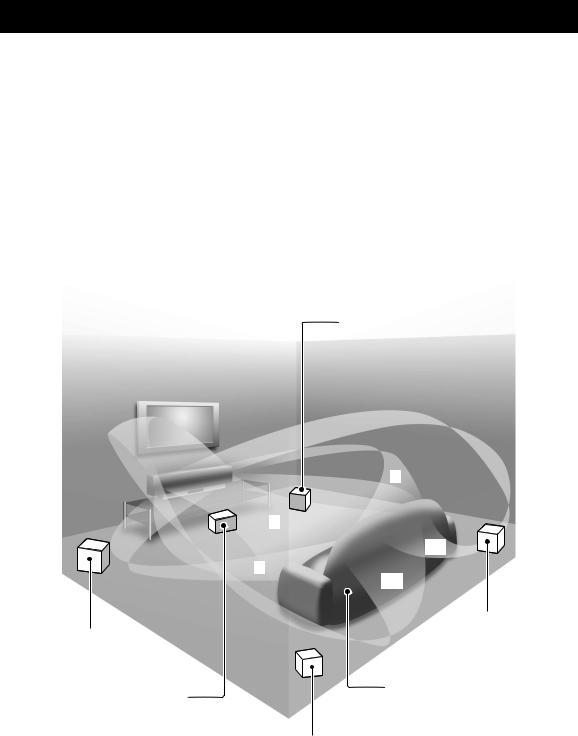
Overview
It is generally accepted that in order to fully enjoy the benefits of surround sound at home, you must endure the agony of wiring and installing a great number of speakers in the hope that your listening room will give you the same kind of surround sound experience as your local movie theater.
Yamaha YSP-4000 Digital Sound Projector challenges this preconception that complicated speaker setup and troublesome wiring go hand-in-hand with the enjoyment of multi-channel surround sound.
This slimline unit does away with the need for complicated wiring and installation worries, leaving you with a unit that is not only easy to set up, but is also capable of reproducing the kind of powerful surround sound you have been waiting for from its built-in 2 woofers and 40 full-range small speakers.
You can fine-tune the parameters of this unit to adjust the delay time for separate sound beams, resulting in highly directional sound that comes in on the listening position from all directions.
The YSP-4000 projects sound beams containing surround sound information for the front right (R), front left (L), surround right (SR), and surround left (SL) speaker positions, which are reflected off the walls of your listening room before reaching the actual listening position. With the addition of center (C) sound beams, this Digital Sound Projector creates true-to-life 5.1-channel surround sound that makes you feel as if there are actual speakers around the room.
Sit back and enjoy the real sound experience of this simple, yet stylish Digital Sound Projector.
Imaginary front left speaker
Imaginary center speaker
Imaginary front right speaker
R
C
SR
L
SL
Imaginary surround right speaker
Listening position
Imaginary surround left speaker
2 En

Features
Digital Sound Projector™
The Digital Sound Projector technology allows one slim unit to control and steer multiple channels of sound to generate multi-channel surround sound, thus eliminates the need for satellite loudspeakers and cabling normally associated with conventional surround sound systems. This unit also employs the beam modes that let you enjoy the surround sound (5 Beam, Stereo plus 3 Beam, 3 Beam, and My Surround), 2-channel and 5-channel stereo playback, and My Beam.
My Surround
In addition to the above mentioned beam modes, this unit is equipped with My Surround beam mode that allows you to enjoy surround system even in a small listening area.
My Beam
This unit employs My Beam that ensures a clear sound in a noisy environment. You can adjust the beam angle manually or automatically using the supplied remote control to the maximum of 45°, rightward and leftward.
Cinema DSP
This unit employs the Cinema DSP technology developed by Yamaha Electronics Corp. that lets you experience movies at home with all the original dramatic sound impact.
HDMI™ (High-Definition Multimedia Interface)
HDMI interface for standard, enhanced, or high-definition video (including 1080p video signal transmission) as well as multi-channel digital audio based on HDCP
Simple and easy connections with HDMI supported external components
Functional link with an HDMI control-compatible TV
Analog video up-scaling from 480i (NTSC)/576i (PAL) or 480p (NTSC)/576p (PAL) to 720p or 1080i
Versatile Remote Control
The supplied remote control comes with preset remote control codes used to control the DVD player, VCR, cable TV tuner, and digital satellite tuner connected to this unit. In addition, the remote control is equipped with the macro capability that enables a series of operations with the press of a single button.
AUTO SETUP (IntelliBeam)
This unit employs the automatic sound beam and acoustic optimization technology with the aid of the supplied IntelliBeam microphone. You can avoid troublesome listening-based speaker setup and achieve highly accurate sound beam adjustments that best match your listening environment.
Compatibility with the Newest Technologies
This unit employs decoders compatible with Dolby Digital, DTS, Dolby Pro Logic, Dolby Pro Logic II, DTS Neo:6, Music Enhancer, and Neural Surround.
Dolby Digital
This is the standard audio signal format used on various digital media such as DVD, Blu-Ray, and HD DVD. This surround technology delivers high-quality digital audio for up to 5.1 discrete channels to produce a directional and more realistic effect.
DTS
This is the standard audio signal format used on various digital media such as DVD, Blu-Ray, and HD DVD. This surround technology delivers high-quality digital audio for up to 5.1 discrete channels to produce a directional and more realistic effect.
Dolby Pro Logic
This sophisticated, matrix decoding technology up-converts any 2-channel source audio to a 5.1-channel full bandwidth playback, resulting in a surround sound experience.
Dolby Pro Logic II
This is a redesigned version of Dolby Pro Logic that employs 2 stereo surround channels, a subwoofer, and a greatly enhanced steering logic. This improved technology provides an exceptionally stable sound field that simulates 5.1 to a much greater degree than the original Dolby Pro Logic.
DTS Neo:6
This technology decodes the conventional 2-channel sources for 6-channel playback, enabling playback with the full-range channels with higher separation. Music mode and Cinema mode are available to play back music and movie sources respectively.
Music Enhancer to improve the sound quality of compression artifacts such as the MP3 format.
Neural Surround decoder (U.S.A and Canada models only)
Sophisticated FM tuner
40-station random and direct preset tuning
Automatic preset tuning
Radio Data System capability (Europe model only)
XM™ Satellite Radio
(U.S.A. and Canada models only)
XM Satellite Radio tuning capability (using the XM MiniTuner Dock, and Antenna sold separately by XM Satellite Radio)
Neural Surround decoder to play back the XM HD content of XM Satellite Radio broadcasts in multi-channels, resulting in a full surround sound experience
XM Satellite Radio information displaying capability
iPod™ Controlling Capability
(U.S.A., Canada, and Australia models only)
DOCK terminal to connect a Yamaha iPod universal dock (such as the YDS-10, sold separately), which supports iPod (Click and Wheel), iPod nano, and iPod mini
Playback information displaying capability
Battery charging capability
INTRODUCTION
English
3 En
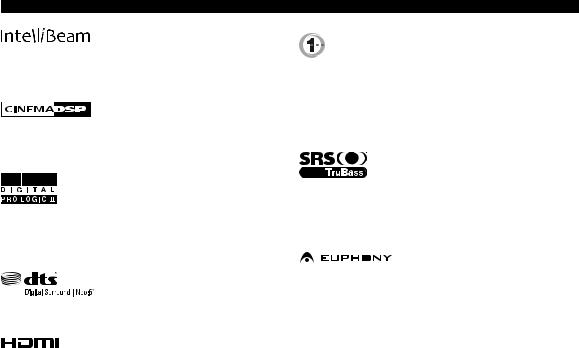
Features
The “




 ” logo and “IntelliBeam” are trademarks of YAMAHA CORPORATION.
” logo and “IntelliBeam” are trademarks of YAMAHA CORPORATION.
The “ ” logo and “Cinema DSP” are registered trademarks of YAMAHA CORPORATION.
” logo and “Cinema DSP” are registered trademarks of YAMAHA CORPORATION.
Manufactured under license from Dolby Laboratories. “Dolby”, “Pro Logic”, and the double-D symbol are trademarks of Dolby Laboratories.
“DTS” and “Neo:6” are registered trademarks of DTS, Inc.
“HDMI”, the “HDMI” logo and “High-Definition Multimedia Interface” are trademarks or registered trademarks of HDMI Licensing LLC.
Manufactured under license from 1 Ltd. Worldwide patents applied for.
The “ ” logo and “Digital Sound Projector™” are trademarks of 1 Ltd.
” logo and “Digital Sound Projector™” are trademarks of 1 Ltd.
TruBass, SRS and the “ 
 ” symbol are registered trademarks of SRS Labs, Inc. TruBass technology is incorporated under license from SRS Labs, Inc.
” symbol are registered trademarks of SRS Labs, Inc. TruBass technology is incorporated under license from SRS Labs, Inc.




 ™ is a trademark of DiMAGIC Co., Ltd.
™ is a trademark of DiMAGIC Co., Ltd.
4 En

Using this manual
Notes
•This manual describes how to connect and operate this unit. For details regarding the operation of external components, refer to the supplied owner’s manual for each component.
•Operations in this manual use keys on the supplied remote control of this unit unless otherwise specified.
•yindicates a tip for your operation.
•This manual is printed prior to production. Designs and specifications are subject to change in part as a result of improvements, etc. In case of differences between the manual and the product, the product has priority.
1Install this unit in your listening room.
See “Installation” on page 17.
2Connect this unit to your TV and other external components.
See “Connections” on page 20.
3Prepare the remote control and turn on the power of this unit.
See “Getting started” on page 32.
4Run AUTO SETUP.
See “AUTO SETUP (IntelliBeam)” on page 37.
5Play back a source.
See “Playback” on page 47.
6Change the beam modes and/or CINEMA DSP settings.
See “Enjoying surround sound” on page 56.
If you want to make additional settings and adjustments
7Run MANUAL SETUP to fine-tune settings and/or set remote control codes.
See “MANUAL SETUP” on page 76 and “Remote control features” on page 103.
INTRODUCTION
English
5 En
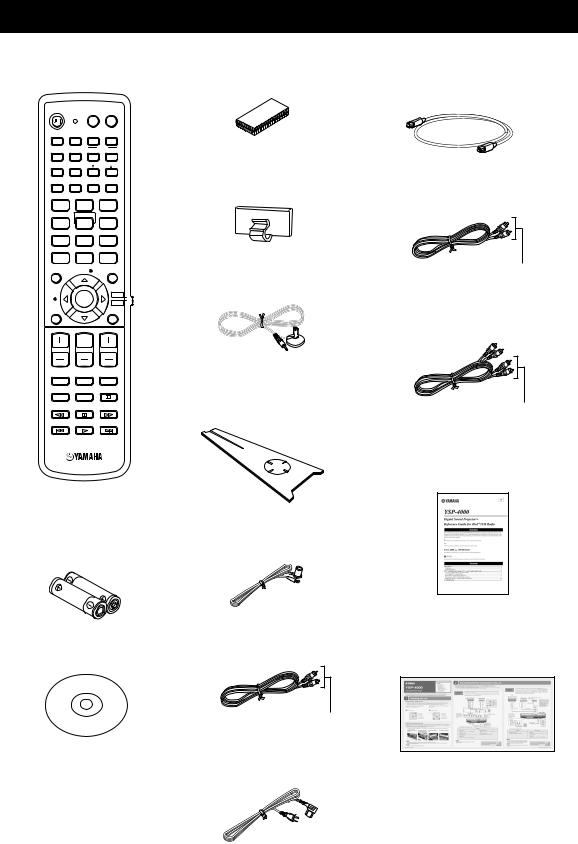
Supplied accessories
Check that you have received all of the following parts.
Remote control (×1)
STANDBY/ON |
POWER |
POWER |
|
|
|
AV |
TV |
|
|
|
DOCK |
DVD |
AUX1 |
AUX2 |
AUX3 |
|
|
TV |
|
|
|
INPUT1 |
MACRO |
STB |
TV |
|
|
PRESET/TUNE SEARCH MEMORY
FM/XM CAT
AUTO
VOL MODE SETUP INPUTMODE SLEEP
Fasteners (×4)
Cable clamp (×1)
5BEAM ST+3BEAM 3BEAM
1 |
2 |
3 |
STEREO |
MY BEAM |
MY SUR. |
4 |
5 |
6 |
MUSIC |
MOVIE |
SPORTS |
7 |
8 |
9 |
OFF |
|
SUR. DECODE |
0 |
+10 |
|
ENHANCER |
ENTRY |
MENU |
CAT/ |
ENTER |
TV/AV |
A-E |
YSP |
|
|
|
|
DISPLAY |
|
RETURN |
VOLUME |
CH |
TV VOL |
MUTE |
TV INPUT |
TV MUTE |
CH LEVEL |
TEST |
CODE SET |
|
(U.S.A. and Canada models)
Batteries (×2)
(AA, R6, UM-3)
IntelliBeam microphone (×1)
Cardboard microphone stand (×1)
Indoor FM antenna (×1)
Optical cable (×1)
Digital audio pin cable (×1)
(Orange)
Audio pin cable (×1)
(White/Red)
REFERENCE GUIDE
(iPod/XM Radio) (×1)
(U.S.A., Canada, and Australia
models only)
Demonstration DVD |
OSD* video pin cable (×1) |
(×1) |
|
|
(Yellow) |
|
* OSD: On-Screen Display |
|
AC power supply cable (×1) |
QUICK REFERENCE
GUIDE
*The number of provided languages varies depending on the model.
6 En

Controls and functions
Front panel
AUX 3 |
INTELLIBEAM MIC |
INPUT |
VOLUME + |
STANDBY/ON |
|
1 |
2 |
|
|
3 |
4 |
5 |
6 |
7 |
AUX 3 |
INTELLIBEAM MIC |
INPUT |
VOLUME + |
STANDBY/ON |
|
|
1 Remote control sensor
Receives infrared signals from the remote control.
2 Front panel display
Shows information about the operational status of this unit.
3 AUX 3 input jack
Connect your portable audio player (see page 27).
4 INTELLIBEAM MIC jack
Connect the supplied IntelliBeam microphone for AUTO SETUP (see page 38).
5 INPUT
Press repeatedly to switch between input sources (see page 47).
Outputs a test tone to experience the sound beam (see page 98).
6 VOLUME +/–
Controls the volume level of all audio channels (see page 49).
7 STANDBY/ON
Turns on the power of this unit or sets it to the standby mode (see page 33).
Notes
•When you turn on this unit, you will hear a click sound followed by the 4 to 5-second interval before sound reproducing.
•In the standby mode, this unit consumes a small amount of power in order to receive infrared signals from the remote control or to search for HDMI signals.
INTRODUCTION
English
7 En
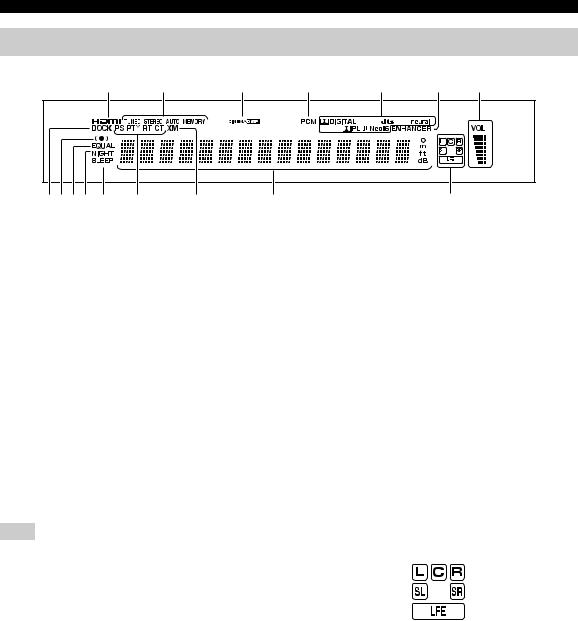
Controls and functions
Front panel display
1 |
|
2 |
3 |
4 |
5 |
6 |
7 |
890A B |
C |
D |
|
E |
|
F |
|
1 HDMI indicator
Lights up when the signal of the selected input source is input at the HDMI IN jack(s).
2 TUNER indicators
FM: Light up when this unit is receiving an FM broadcast. XM: MEMORY flashes during the XM preset operation (U.S.A. and Canada models only).
3 CINEMA DSP indicator
Lights up when a sound field program is selected (see page 67).
4 PCM indicator
Lights up when this unit is reproducing PCM (Pulse Code Modulation) digital audio signals.
5 Decoder indicators
Light up when the corresponding decoder operates (see page 58).
Note
The neural decoder is available for the U.S.A. and Canada models only.
6 ENHANCER indicator
Lights up when the Music Enhancer is selected (see page 70).
7Volume level indicator
Displays the current volume level.
8DOCK indicator
(U.S.A., Canada, and Australia models only)
Lights up when your iPod (Click and Wheel), iPod nano, or iPod mini is connected to this unit via the DOCK terminal on this unit.
9 SRS TruBass indicator
Lights up when TruBass is turned on (see page 84).
0 EQUAL indicator
Lights up when the TV volume equal mode is selected (see page 71).
A NIGHT indicator
Lights up when one of the night listening enhancers is selected (see page 71).
B SLEEP indicator
Lights up when the sleep timer is set (see page 72).
CRadio Data System indicators (Europe model only)
Show the current Radio Data System status.
DXM indicator
(U.S.A. and Canada models only)
Lights up when XM is selected as the input source.
E Multi-information display
Shows information with alphanumeric characters when you adjust the parameters of this unit.
F Input channel indicators
Show information when you adjust the parameters of this unit. The channel component of the current digital input signal is displayed (see page 58).
y
You can adjust the brightness and display setting of the front panel display using the F.DISPLAY SET parameter in MANUAL SETUP (see page 88).
8 En
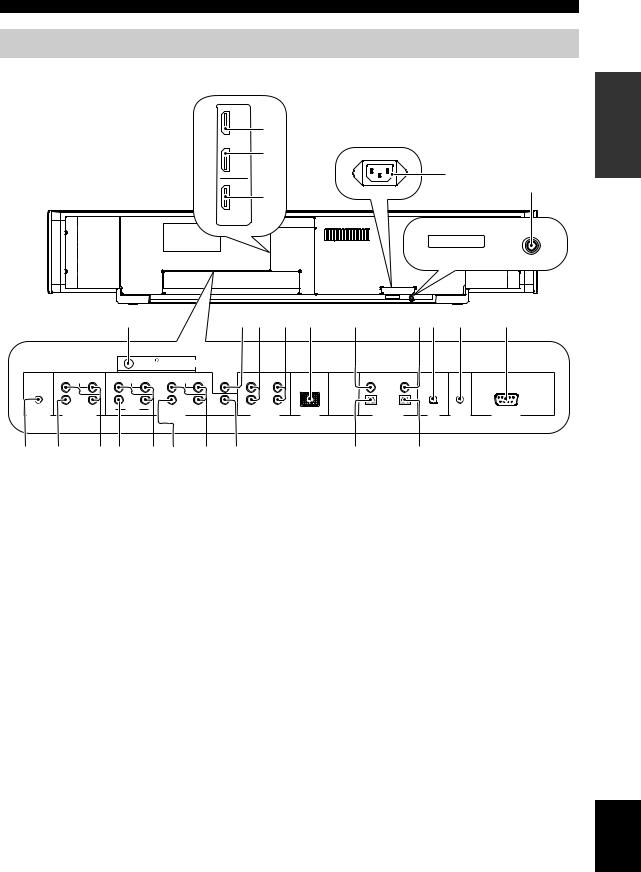
Controls and functions
Rear panel
The illustration below shows the rear panel of the U.S.A. and Canada models.
AUX 1 |
1 |
|
DVD |
2 |
|
IN |
4 |
|
(U.S.A. and Canada models) |
5 |
|
3 |
||
|
||
OUT |
|
|
HDMI |
|
|
|
IR-OUT |
INTRODUCTION
|
|
IR-OUT |
6 |
7 8 9 0 A |
BC D E |
|
|
FM75 |
|
ANTENNA |
|
|
|
|
|
|
|
|
|
|
|
UNBAL. |
|
|
|
|
|
|
|
|
|
||
|
|
|
SUBWOOFER |
|
|
|
|
|
|
|
|
||
|
COMPONENT |
COMPONENT |
|
COMPONENT |
|
|
|
DVD |
AUX 2 |
|
|
|
|
|
|
|
|
|
|
|
|
|
|||||
|
|
|
|
|
|
|
|
|
COAXIAL |
|
|
|
|
|
|
|
|
|
|
|
|
|
OPTICAL |
|
|
|
|
SYSTEM |
VIDEO OUT |
STB |
|
DVD/AUX 2 |
AUX 1 |
TV/STB |
AUX 1 |
DOCK |
TV/STB |
AUX 1 |
XM |
IR IN |
RS-232C |
CONNECTOR |
|
VIDEO IN |
|
AUDIO IN |
DIGITAL IN |
||||||||
F G H I J K L M N O
1 AUX 1 HDMI IN jack
Connect your digital satellite tuner, cable TV tuner, digital air wave tuner, or game console via an HDMI connection (see page 22).
2 DVD HDMI IN jack
Connect your DVD player via an HDMI connection (see page 22).
3 HDMI OUT jack
Connect to the HDMI IN jack on your HDMI component such as a TV or a projector connected to this unit (see page 22).
4 AC IN
Connect the supplied AC power supply cable (see page 31).
5 IR-OUT terminal
This is a control expansion terminal for commercial use only (see page 30).
6 ANTENNA jack
Connect the FM antenna (see page 30).
7 SUBWOOFER jack
Connect your subwoofer (see page 29).
8 TV/STB AUDIO IN jacks
Connect your TV, digital satellite tuner, or cable TV tuner via an analog connection (see pages 23 and 25).
9 AUX 1 AUDIO IN jacks
Connect an external component via an analog connection (see page 24).
0DOCK terminal
(U.S.A., Canada, and Australia models only)
Connect the Yamaha iPod universal dock (such as YDS10, sold separately) (see page 2 in the Reference Guide).
A DVD COAXIAL DIGITAL IN jack
Connect your DVD player via a coaxial digital connection (see page 24).
B AUX 2 COAXIAL DIGITAL IN jack
Connect an external component via a coaxial digital connection (see page 28).
English
9 En

Controls and functions
CXM antenna jack
(U.S.A and Canada models only)
Connect your XM Mini-Tuner Dock (sold separately) (see page 5 in the Reference Guide).
D IR IN terminal
This is a control expansion terminal for commercial use only (see page 30).
E RS-232C terminal
This is a control expansion terminal for commercial use only (see page 30).
FSYSTEM CONNECTOR terminal (U.S.A. and Canada models only)
Use to connect a Yamaha subwoofer equipped with a SYSTEM CONNECTOR terminal to this unit.
G VIDEO OUT jack
Connect to the video input jack of your TV via a composite analog video connection to display the OSD of this unit (see page 23).
HCOMPONENT VIDEO OUT jacks
Connect to the video input jacks of your TV via a component analog video connection to display the OSD of this unit (see page 23).
ISTB VIDEO IN jacks
Connect a digital satellite tuner or a cable TV tuner via a composite analog video connection (see pages 25 to 26).
J STB COMPONENT VIDEO IN jacks
Connect a digital satellite tuner or a cable TV tuner via a component analog video connection (see pages 25 to 26).
K DVD/AUX 2 VIDEO IN jacks
Connect a DVD player/recorder or an external component via a composite analog video connection
(see pages 24 and 28).
LDVD/AUX 2 COMPONENT VIDEO IN jacks
Connect a DVD player/recorder or an external component via a component analog video connection (see pages 24 and 28).
MAUX 1 VIDEO IN jacks
Connect an external component via a composite analog video connection (see page 28).
N TV/STB OPTICAL DIGITAL IN jack
Connect your TV, digital satellite tuner, or cable TV tuner via an optical digital connection (see pages 23 and 25).
O AUX 1 OPTICAL DIGITAL IN jack
Connect an external component via an optical digital connection (see page 28).
10 En
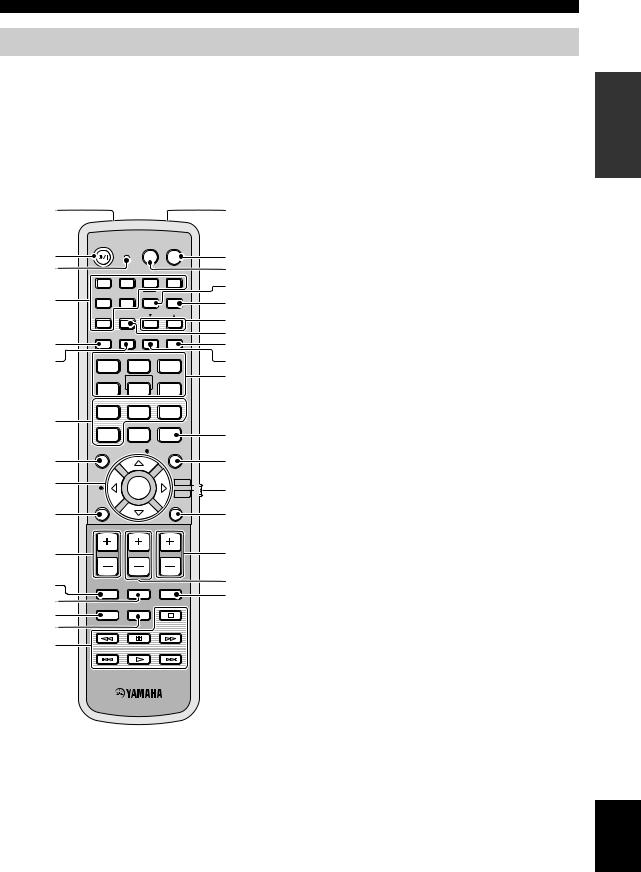
Controls and functions
Remote control (Europe, Australia, Asia, and Korea models)
This section describes the functions of the remote control used to control this unit. Some buttons marked with an asterisk (*) share the common functions between the YSP and TV/AV operation modes (S).
y
You can also control other components using the remote control once you set the appropriate remote control codes. See “Controlling other components” on page 104 for details.
1 |
|
|
|
|
G |
|
|
STANDBY/ON |
POWER POWER |
|
|
||
* 2 |
|
|
AV |
TV |
H |
* |
3 |
|
|
|
|
I |
* |
|
DVD |
AUX1 |
AUX2 |
AUX3 |
J |
* |
|
|
|||||
* 4 |
|
|
TV |
|
||
|
|
INPUT1 |
MACRO |
K |
||
STB |
TV |
|
|
|
||
|
PRESET/TUNE SEARCH |
MEMORY |
L |
|
||
|
FM |
A-E |
|
|
|
|
|
|
AUTO |
|
|
M |
|
5 |
VOL MODE SETUP INPUTMODE SLEEP |
|
||||
|
|
|
|
N |
|
|
6 |
5BEAM |
ST+3BEAM |
3BEAM |
O |
|
|
1 |
|
2 |
3 |
|
||
|
|
P |
|
|||
|
STEREO |
MY BEAM |
MY SUR. |
|
||
|
4 |
|
5 |
6 |
|
|
|
MUSIC |
MOVIE |
SPORTS |
|
|
|
7 |
7 |
|
8 |
9 |
|
|
OFF |
|
SUR. DECODE |
|
|
||
|
0 |
+10 |
|
Q |
|
|
|
ENHANCER |
ENTRY |
MENU |
|
|
|
8 |
|
|
|
|
R |
|
9 |
A-E |
ENTER |
TV/AV |
S |
|
|
|
YSP |
|
||||
|
|
|
|
|
||
DISPLAY |
RETURN |
0 |
t |
VOLUME |
CH |
TV VOL |
1 Infrared window
Outputs infrared control signals. Aim this window at the component you want to operate.
2 STANDBY/ON
Sets this system to the standby mode (see page 33).
3 Transmission indicator
Lights up when infrared control signals are being output.
4 Input selector buttons
Use to select an input source (DVD, AUX1, AUX2, AUX3, STB, TV, or FM).
5 VOL MODE
Turns on or off the volume modes (see page 71).
6 AUTO SETUP
Enters the AUTO SETUP menu (see page 37).
7 CINEMA DSP program buttons
Select the CINEMA DSP programs (see page 65).
8 ENHANCER
Turns on or off the Music Enhancer (see page 70).
9 Cursor buttons  /
/  /
/  /
/  , ENTER
, ENTER
Select and adjust SET MENU items.
0 DISPLAY
Displays information on the selected input signal.
A VOLUME +/–
Increases or decreases the volume level of this unit (see page 49).
*A
*B
*CD E
F
MUTE |
TV INPUT |
CH LEVEL |
TEST |
TV MUTE |
CODE SET |
U*
V*
W*
B MUTE
Mutes the sound. Press again to restore the audio output to the previous volume level (see page 49).
C TV INPUT
Toggles between the input sources on the TV (see page 104).
D CH LEVEL
Adjusts the volume level of each channel (see page 91).
E TEST
Outputs a test tone when adjusting the output level of each channel (see page 90).
INTRODUCTION
English
11 En

Controls and functions
F DVD player/VCR control buttons
Control your DVD player or VCR (see pages 105 and 106).
G My Beam microphone
Collects the test tones from this unit when using the My Beam auto-adjust function (see page 63).
H TV POWER
Turns on the power of your TV or sets it to the standby mode (see page 104).
I AV POWER
Turns on the power of the selected component or sets it to the standby mode (see pages 105 and 106).
J INPUT1
Switches the input source on your TV (see page 104).
K MACRO
Use to set the TV macro (see page 107).
L /5
Switches the preset station number (1 to 8) when this unit is receiving an FM broadcast (see page 54).
M A-E
Switches the preset station group (A to E) when this unit is receiving an FM broadcast (see page 54).
N SLEEP
Sets the sleep timer (see page 72).
O INPUTMODE
Toggles between input modes (AUTO, DTS, and ANALOG) (see page 93).
P Beam mode buttons
Change the beam mode settings (see pages 56, 62, and 63).
Q SUR. DECODE
Selects the surround mode for playback (see page 59).
R MENU
Displays the setup menu on your TV monitor (see pages 39 and 77).
S Operation mode selector
Selects the operation mode of this unit. Select YSP when operating this unit and select TV/AV when operating your TV or other AV components.
T RETURN
Selects sleep timer settings or returns to the previous SET MENU screen.
U TV VOL +/–
Adjusts the volume level of your TV (see page 104).
V CH +/–
Changes the channels of your TV, digital satellite tuner, cable TV tuner, or VCR (see pages 104 and 106).
W TV MUTE, CODE SET
Mutes the audio output of your TV (see page 104). Sets up remote control codes (see page 103).
Note
The functions L and M are available only when the FM stations are preset.
12 En
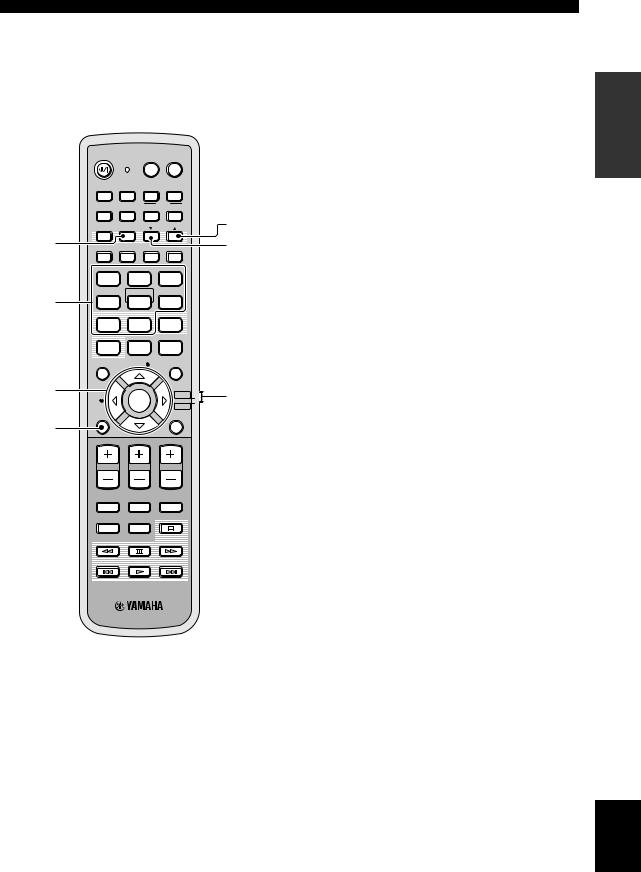
This section describes the functions of the remote control used to control FM, Radio Data System, or iPod when the TV/AV mode is selected with the operation mode selector (7). Note that the Radio Data System controls are available for Europe model only, and the iPod controls are available for Australia model only.
STANDBY/ON |
POWER |
POWER |
|
AV |
TV |
|
DVD |
AUX1 |
AUX2 |
AUX3 |
|
|
|
|
TV |
|
|
|
|
|
INPUT1 |
MACRO |
|
|
STB |
TV |
|
|
5 |
|
PRESET/TUNE |
SEARCH |
MEMORY |
||
|
|
A-E |
|
|
|
1 |
FM |
|
|
|
6 |
|
AUTO |
|
|
||
|
VOL MODE SETUP INPUTMODE SLEEP |
||||
|
5BEAM |
ST+3BEAM |
3BEAM |
|
|
|
1 |
2 |
|
3 |
|
|
STEREO |
MY BEAM |
MY SUR. |
|
|
2 |
4 |
5 |
|
6 |
|
|
MUSIC |
MOVIE |
SPORTS |
|
|
|
7 |
8 |
|
9 |
|
|
OFF |
|
SUR. DECODE |
|
|
|
0 |
+10 |
|
|
|
|
ENHANCER |
ENTRY |
MENU |
|
|
3 |
|
|
|
TV/AV |
7 |
|
A-E |
ENTER |
|||
|
|
||||
YSP
DISPLAY |
RETURN |
4 |
|
VOLUME |
CH |
TV VOL |
MUTE |
TV INPUT TV MUTE |
CH LEVEL |
CODE SET |
TEST |
Controls and functions
1 PRESET/TUNE
FM: Switches between the preset search mode and the frequency search mode (see pages 51 to 54).
2Numeric buttons
FM: Enter numbers.
3Cursor buttons  /
/  /
/  /
/  , ENTER
, ENTER
FM: Use ENTRY  (
( /
/ ) to change the preset station number (1 to 8) or frequency level (see pages 51 to 54). Use A-E
) to change the preset station number (1 to 8) or frequency level (see pages 51 to 54). Use A-E  (
( /
/ ) to change the preset station group (A to E) (see pages 53 and 54). Use ENTER to confirm the input above.
) to change the preset station group (A to E) (see pages 53 and 54). Use ENTER to confirm the input above.
y
These functions are also available when this unit is receiving the Radio Data System (see page 54) or playing back your iPod (see page 2 in the Reference Guide).
4 DISPLAY
Radio Data System and iPod: Displays information when this unit is receiving the Radio Data System (see page 54) or playing back your iPod (see page 2 in the Reference Guide).
5 MEMORY
FM: Stores the preset stations (see pages 52 and 53).
y
This function is also available when this unit is receiving the Radio Data System (see page 54).
6 SEARCH
FM: Switches between automatic and manual tuning (see page 51).
7 Operation mode selector
Selects the operation mode of this unit. Select YSP when operating this unit and select TV/AV when operating your TV or other AV components.
INTRODUCTION
English
13 En
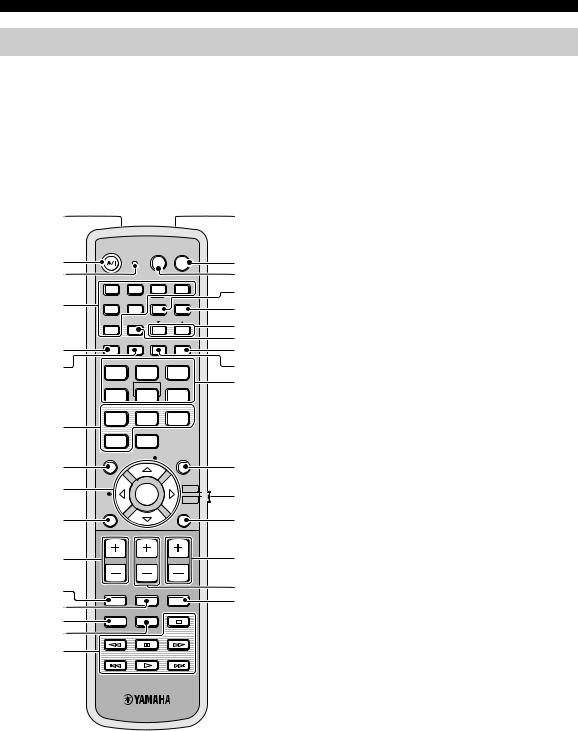
Controls and functions
Remote control (U.S.A. and Canada models)
This section describes the functions of the remote control used to control this unit. Some buttons marked with an asterisk (*) share the common functions between the YSP and TV/AV operation modes (S).
y
You can also control other components using the remote control once you set the appropriate remote control codes. See “Controlling other components” on page 104 for details.
|
1 |
|
|
|
|
G |
|
* |
|
STANDBY/ON |
POWER POWER |
|
* |
||
2 |
|
|
AV |
TV |
H |
||
|
3 |
|
|
|
DOCK |
I |
* |
|
|
DVD |
AUX1 |
AUX2 |
AUX3 |
J |
* |
* |
4 |
|
|
|
TV |
|
|
|
|
INPUT1 |
MACRO |
K |
|||
|
|
|
|||||
|
STB |
TV |
|
|
|
||
|
|
PRESET/TUNE SEARCH MEMORY |
L |
|
|||
|
|
FM/XM |
CAT |
|
|
|
|
|
|
|
|
|
|
||
|
|
VOL MODE |
AUTO |
|
|
M |
|
|
5 |
SETUP INPUTMODE SLEEP |
N |
|
|||
|
|
|
|
|
|
||
|
6 |
5BEAM |
ST+3BEAM |
3BEAM |
O |
|
|
|
|
1 |
|
2 |
3 |
P |
|
|
|
STEREO |
MY BEAM |
MY SUR. |
|
||
|
|
4 |
|
5 |
6 |
|
|
|
|
MUSIC |
MOVIE |
SPORTS |
|
|
|
|
7 |
7 |
|
8 |
9 |
|
|
|
OFF |
|
SUR. DECODE |
|
|
||
1 Infrared window
Outputs infrared control signals. Aim this window at the component you want to operate.
2 STANDBY/ON
Sets this system to the standby mode (see page 33).
3 Transmission indicator
Lights up when infrared control signals are being output.
4 Input selector buttons
Use to select an input source (DVD, AUX1, AUX2, AUX3/DOCK, STB, TV, or FM/XM).
5 VOL MODE
Turns on or off the volume modes (see page 71).
6 AUTO SETUP
Enters the AUTO SETUP menu (see page 37).
7 Sound field program buttons
Select the sound field programs (see page 65).
8 ENHANCER
Turns on or off the Music Enhancer (see page 70).
9 Cursor buttons  /
/  /
/  /
/  , ENTER
, ENTER
Select and adjust SET MENU items.
8
9
0
*A
*B
*CD E
F
0 +10  Q
Q
ENHANCER |
ENTRY |
MENU |
R |
|
|
|
|
||
CAT/ |
ENTER |
TV/AV |
S |
|
|
||||
A-E |
YSP |
|||
|
||||
|
|
DISPLAY |
RETURN |
|
t |
VOLUME |
CH |
TV VOL |
|
|
|
U * |
|
|
|
V |
MUTE |
TV INPUT |
TV MUTE |
* |
CH LEVEL |
TEST |
CODE SET |
W * |
|
|
0 DISPLAY
Displays information on the selected input signal.
A VOLUME +/–
Increases or decreases the volume level of this unit (see page 49).
B MUTE
Mutes the sound. Press again to restore the audio output to the previous volume level (see page 49).
C TV INPUT
Toggles between the input source on your TV (see page 104).
D CH LEVEL
Adjusts the volume level of each channel (see page 91).
E TEST
Outputs a test tone when adjusting the output level of each channel (see page 90).
14 En

F DVD player/VCR control buttons
Control your DVD player or VCR (see pages 105 and 106).
G My Beam microphone
Collects the test tones from this unit when using the My Beam auto-adjust function (see page 63).
H TV POWER
Turns on the power of your TV or sets it to the standby mode (see page 104).
I AV POWER
Turns on the power of the selected component or sets it to the standby mode (see pages 105 and 106).
J INPUT1
Switches the input source on your TV (see page 104).
K MACRO
Use to set the TV macro (see page 107).
L /5
Switches the preset station number (1 to 8) when this unit is receiving an FM broadcast or XM channel (see
page 54).
M CAT
Switches the preset station group (A to E) when this unit is receiving an FM broadcast or XM channel (see page 54).
N SLEEP
Sets the sleep timer (see page 72).
O INPUTMODE
Toggles between input modes (AUTO, DTS, and ANALOG) (see page 93).
P Beam mode buttons
Change the beam mode settings (see pages 56, 62, and 63).
Q SUR. DECODE
Selects the surround mode for playback (see page 59).
R MENU
Displays the setup menu on your TV monitor (see pages 39 and 77).
S Operation mode selector
Selects the operation mode of this unit. Select YSP when operating this unit and select TV/AV when operating your TV or other AV components.
Controls and functions
T RETURN
Selects sleep timer settings or returns to the previous SET MENU screen.
U TV VOL +/–
Adjusts the volume level of your TV (see page 104).
V CH +/–
Changes the channels of your TV, digital satellite tuner, cable TV tuner, or VCR (see pages 104 and 106).
W TV MUTE, CODE SET
Mutes the audio output of your TV (see page 104). Sets up remote control codes (see page 103).
Note
The functions L and M are available only when the FM/XM stations are preset.
INTRODUCTION
English
15 En
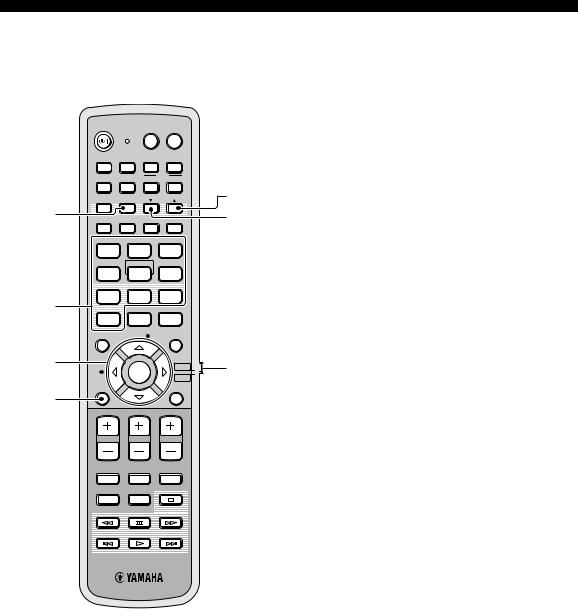
Controls and functions
This section describes the functions of the remote control used to control FM, XM Satellite Radio, or iPod when the TV/AV mode is selected with the operation mode selector (7).
|
STANDBY/ON |
POWER POWER |
|
||
|
|
|
AV |
TV |
|
|
|
|
|
DOCK |
|
|
DVD |
AUX1 |
AUX2 |
AUX3 |
|
|
|
|
TV |
|
|
|
|
|
INPUT1 |
MACRO |
|
|
STB |
TV |
|
|
5 |
|
PRESET/TUNE |
SEARCH |
MEMORY |
||
|
FM/XM |
CAT |
|
|
|
1 |
|
AUTO |
|
|
6 |
|
VOL MODE SETUP INPUTMODE SLEEP |
||||
|
5BEAM |
ST+3BEAM |
3BEAM |
|
|
|
1 |
2 |
3 |
|
|
|
STEREO |
MY BEAM |
MY SUR. |
|
|
|
4 |
5 |
6 |
|
|
|
MUSIC |
MOVIE |
SPORTS |
|
|
2 |
7 |
8 |
9 |
|
|
OFF |
|
SUR. DECODE |
|
||
|
0 |
+10 |
|
|
|
|
ENHANCER |
ENTRY |
MENU |
|
|
3 |
CAT/ |
|
|
TV/AV |
7 |
|
ENTER |
||||
|
|
||||
|
A-E |
|
|
YSP |
|
|
|
|
|
|
|
DISPLAY |
RETURN |
4 |
|
VOLUME |
CH |
TV VOL |
MUTE |
TV INPUT TV MUTE |
CH LEVEL |
CODE SET |
TEST |
1 PRESET/TUNE
FM: Switches between the preset search mode and the frequency search mode (see pages 51 to 54).
2Numeric buttons
FM, XM: Enter numbers.
3Cursor buttons  /
/  /
/  /
/  , ENTER
, ENTER
FM: Use ENTRY  (
( /
/ ) to change the preset station number (1 to 8) or frequency level (see pages 51 to 54). Use CAT/A-E
) to change the preset station number (1 to 8) or frequency level (see pages 51 to 54). Use CAT/A-E  (
( /
/ ) to change the preset station group (A to E) (see pages 53 and 54). Use ENTER to confirm the input above.
) to change the preset station group (A to E) (see pages 53 and 54). Use ENTER to confirm the input above.
XM: Use ENTRY  (
( /
/ ) to select XM channels in All Channel Search mode/Category Search mode, and to select the preset channel number (1 to 8) in Preset Search mode. Use CAT/A-E
) to select XM channels in All Channel Search mode/Category Search mode, and to select the preset channel number (1 to 8) in Preset Search mode. Use CAT/A-E  (
( /
/ ) to select XM categories in All Channel Search mode/Category Search mode, and to select the preset channel group (A to E) in Preset Search mode. Use ENTER to confirm the input above (see pages 7 and 8 in the Reference Guide).
) to select XM categories in All Channel Search mode/Category Search mode, and to select the preset channel group (A to E) in Preset Search mode. Use ENTER to confirm the input above (see pages 7 and 8 in the Reference Guide).
y
These functions are also available when this unit is playing back your iPod (see page 2 in the Reference Guide).
4 DISPLAY
XM and iPod: Displays information when this unit is receiving an XM channel (see page 10 in the Reference Guide) or playing back your iPod (see page 3 in the Reference Guide).
5 MEMORY
FM: Stores the preset stations (see pages 52 and 53). XM: Use to store the preset stations (see page 9 in the Reference Guide).
6 SEARCH
FM: Switches between automatic and manual tuning (see page 51).
XM: Switches between search modes (All Channel Search, Category Search, and Preset Search) (see pages 7 and 8 in the Reference Guide).
7 Operation mode selector
Selects the operation mode of this unit. Select YSP when operating this unit and select TV/AV when operating your TV or other AV components.
16 En
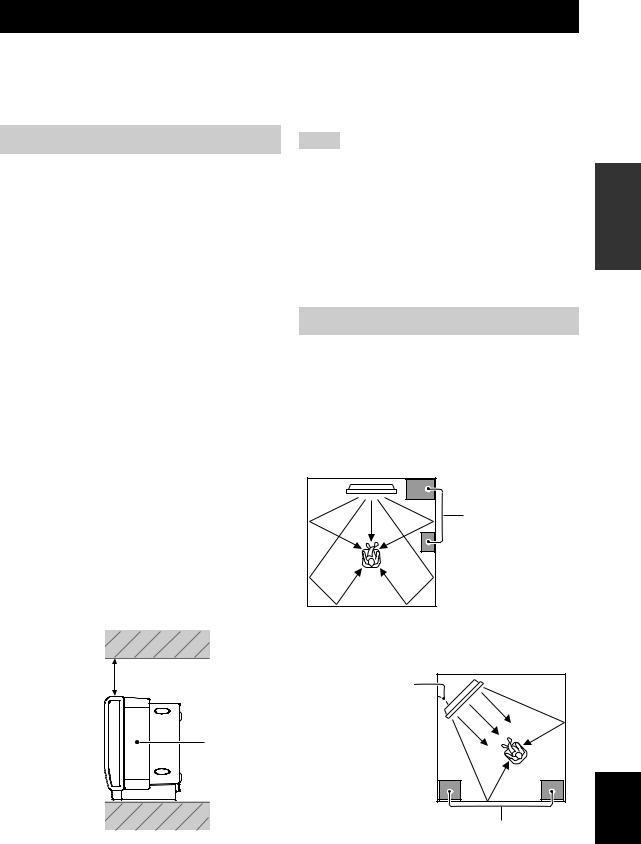
Installation
This section describes a suitable installation location to install this unit using a metal wall bracket, a rack or a stand. Depending on your installation environment, connections with external components can be done before installing this unit. We recommend that you temporarily place and arrange all components, including this unit, in order to decide which procedure should come first. Especially when you make a connection over HDMI, we recommend that you make a connection first before installation (see page 22).
Before installing this unit
This unit creates surround sound by reflecting projected sound beams off the walls of your listening room. The surround sound effects produced by this unit may not be sufficient when this unit is installed in the following locations.
•Rooms with walls inadequate for reflecting sound beams
•Rooms with acoustically absorbent walls
•Rooms with measurements outside the following range: W (3 to 7 m (10 to 23 ft)) x H (2 to 3.5 m (7 to 11.5 ft)) x D (3 to 7 m (10 to 23 ft))
•Rooms with less than 1.8 m (6 ft) from the listening position to this unit
•Rooms where objects such as furniture are likely to obstruct the path of sound beams
•Rooms where the listening position is close to the walls
•Rooms where the listening position is not in front of this unit
y
•You can enjoy surround sound by selecting My Surround (see page 57) as the beam mode even if your listening room may not fulfill the above conditions (except when the listening position is not directly facing toward the front of this unit).
•You can also enjoy surround sound by selecting 2-channel or 5-channel stereo playback (see page 62) or My Beam (see page 63) as the beam mode even if your listening room may not fulfill the above conditions.
Make sure you leave an adequate amount of ventilation space so that heat can escape. Make at least 5 cm (2 in) of space above or below this unit.
Side view
Notes
•We do not recommend putting this unit directly on the floor of your listening room. Please install this unit using a metal wall bracket, a rack, or a stand.
•This unit weighs 15.5 kg (34 lbs 3 oz). Be sure to install this unit where it will not fall subject to vibrations, such as from an earthquake, and where it is out of the reach of children.
•When using a cathode-ray tube (CRT) TV, do not install this unit directly above your TV.
•This unit is shielded against magnetic rays. However, if the picture on your TV screen becomes blurred or distorted, we recommend moving this unit away from your TV.
Installing this unit
Install this unit where there are no obstacles such as furniture obstructing the path of sound beams. Otherwise, the desired surround sound effects may not be achieved. You may install this unit in parallel with the wall or in the corner.
Parallel installation
Install this unit in the exact center of the wall when it is measured from the left and right corners.
An object, such as furniture
Corner installation
PREPARATION
|
|
Install this unit in the corner at a 40º to 50º angle from the |
|
|
|
adjacent walls. |
|
|
5 cm (2 in) or more |
40° to 50° |
|
|
|
|
|
Front |
Rear |
|
|
|
Side |
|
|
|
|
An object, such as furniture |
English |
|
|
|
17 En
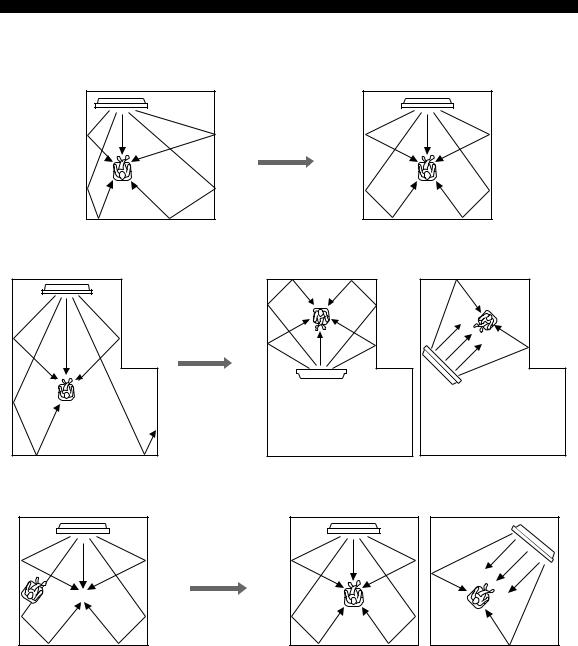
Installation
■ Installation examples
Example 1
Install this unit as close to the exact center of the wall as possible.
Example 2
Install this unit so that the sound beams can be reflected off the walls.
Example 3
Install this unit as close to the exact front of your normal listening position as possible.
18 En
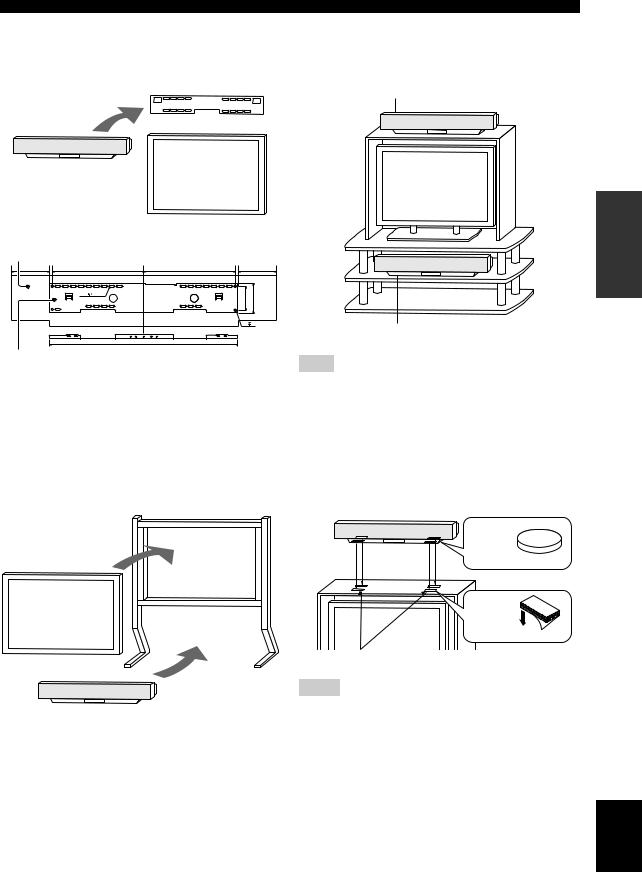
■ Using a metal wall bracket
You can use the optional metal wall bracket (such as SPMK30) to mount this unit on the wall in your listening room.
Metal wall bracket
This unit
|
|
TV |
|
YSP-4000 |
|
|
|
150 |
355 |
355 |
150 |
|
247x22 |
92 |
112 |
|
|
||
|
|
4- 7 |
|
|
|
730 |
(mm) |
SPM-K30 (Option)
y
Refer to the instructions supplied with the metal bracket for details on how to attach the metal bracket to the wall or how to attach this unit to the metal bracket.
■ Using a stand
You can mount your TV on a stand placed on a commercially available rack and install this unit under your TV.
Stand
TV
This unit
y
Refer to the instructions supplied with the stand for details on how to install the stand or how to mount and the TV on the stand.
Installation
■ Using a rack
You can install this unit either above or under your TV in a commercially available rack.
When this unit is installed above your TV
PREPARATION
When this unit is installed under your TV
Note
Make sure that the rack is large enough to allow adequate ventilation space around this unit (see page 17) and that it is strong enough to support the weight of both this unit and your TV.
■ Affixing this unit
Peel off the film from each of the four supplied fasteners and then secure them to the bottom four corners of this unit and the top of the rack, etc.
This unit
Peel off the pad on the bottom
Peel off 2 the film
 1
1
Fasteners
Notes
•Do not install this unit on top of a slanted surface. This unit may fall over and cause injury.
•Make sure you wipe the surface of the rack, etc. before securing the fasteners. Applying the tape to a dirty or wet surface will weaken the sticking power of the tape, and this unit may fall as a result.
English
19 En

Connections
This unit is equipped with the following types of audio/video input/output jacks/terminal:
For audio input |
For audio output |
|
• 2 optical digital input jacks |
• 1 subwoofer output jack |
|
• 2 coaxial digital input jacks |
For audio/video output |
|
• 2 sets of analog input jacks |
||
• 1 HDMI output jack |
||
• 1 universal dock terminal |
||
|
||
(U.S.A., Canada, and Australia models only) |
For video output |
|
For audio/video input |
• 1 composite video output jack |
|
• 1 set of component video output jacks |
||
• 2 HDMI input jacks |
||
|
For video input
•3 composite video input jacks
•2 sets of component video input jacks
Use these jacks/terminal to connect external components such as your TV, DVD player, VCR, digital satellite tuner, cable TV tuner, digital air wave tuner, portable audio player, game console, and iPod. Further, by connecting a subwoofer to this unit, you can enjoy reinforced low-bass sounds. For details on how to connect various types of external components to this unit, see pages 22 to 29.
CAUTION
•Do not connect this unit or other components to the mains power until all connections between components are complete.
•Unplug the AC power supply cable before changing connections, moving or cleaning this unit.
Audio connection |
Video connection |
TV
This unit |
|
|
|
|
|
|
|
|
|
|
|
|
|
|
|
|
|
|
|
|
|
|
|
|
|
|
|
|
|
|
|
|
|
|
|
|
|
|
|
|
|
|
|
|
|
|
|
|
|
|
|
|
|
|
|
|
|
|
|
|
|
|
|
|
|
|
|
|
|
|
|
|
|
|
|
|
|
|
|
|
|
|
|
|
|
|
|
|
|
|
|
|
|
|
|
|
|
|
|
|
|
|
|
|
|
|
|
|
|
|
|
|
|
|
|
|
|
|
|
|
|
|
|
|
|
|
|
|
|
|
|
|
|
|
|
|
|
|
|
|
|
|
|
|
|
|
|
|
|
|
|
|
|
|
|
|
|
|
|
|
|
|
|
|
DVD player |
|
|
Subwoofer |
|
portable audio |
Digital satellite tuner |
VCR or game console |
|
||||||||||||||||
|
|
|
|
|
|
|
|
|
|
|
|
player |
or cable TV tuner |
|
|
|
|
|
|
|||||||
20 En

Before connecting components
■ Cables used for connections
Audio/Video
A HDMI cable
Audio |
|
Audio pin cable (supplied) |
|
(White) |
(White) |
(Red) |
(Red) |
Optical cable (supplied)
Digital audio pin cable (supplied)
(Orange) 

 (Orange)
(Orange)
3.5 mm stereo mini plug cable
5 Subwoofer pin cable
Video
OSD video pin cable (supplied) / Video pin cable
(Yellow) |
(Yellow) |
Component video pin cable
(Green) |
(Green) |
(Blue) |
(Blue) |
(Red) |
(Red) |
■ Notes on connecting the optical cable
•Pull out the cap before connecting the optical cable.
When you are not using the optical cable, be sure to put the cap back in place.
•When inserting the cable into the optical digital jack, make sure the direction is correct.
Cap
Connections
■ Affixing cables
To prevent cables from becoming unplugged, place the supplied cable clamp with the open side facing upward, attach it to the rear panel of this unit in a suitable position, and then affix cables in the cable clamp.
Optical cable
 Attach to this unit
Attach to this unit
■ Information on HDMI™
Audio signals
Input source |
Audio signal type |
|
|
|
|
DVD video |
Dolby Digital, DTS, PCM |
|
|
|
|
DVD audio |
2-channel stereo |
|
(up to 96 kHz/24 bit) |
||
|
||
|
|
|
Blu-ray Disc |
Dolby Digital, DTS, PCM |
|
HD DVD |
||
|
||
|
|
Notes
•When CPPM copy-protected DVD audio is played back, video and audio signals may not be output depending on the type of DVD player.
•This unit is not compatible with HDCP-incompatible HDMI or DVI components.
y
•We recommend that you use an HDMI cable shorter than 5 m (16 ft) with the HDMI logo printed on it.
•Use a conversion cable (HDMI jack ↔ DVI-D jack) to connect this unit to other DVI components.
■ Priority order for audio input signals
When multiple types of audio signals are simultaneously being input from a single source component, this unit plays back the audio signals in the following priority order: HDMI → Digital → Analog
As default settings, the following input jacks are assigned to the corresponding input sources:
Input |
|
|
|
Input jack |
HDMI |
Digital |
Analog |
Source |
|
|
|
|
|
|
|
TV/STB
DVD
AUX 1
AUX 2
AUX 3
PREPARATION
English
21 En
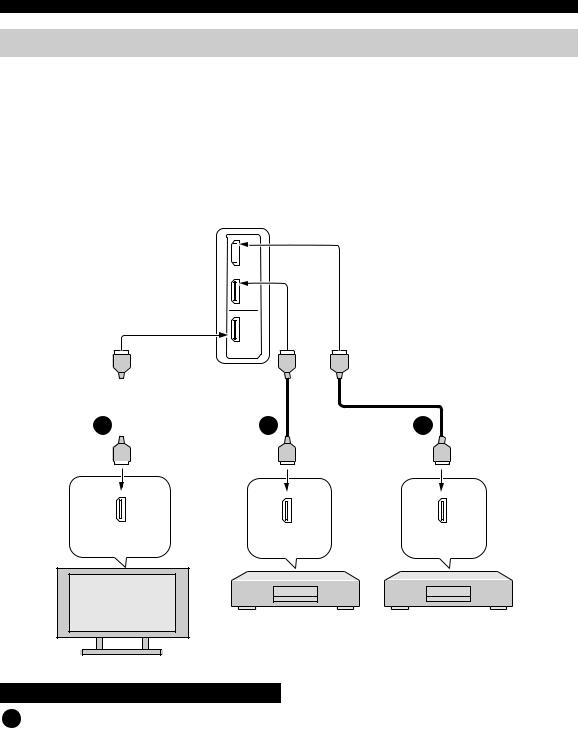
Connections
Connections using HDMI cables
This unit is equipped with 2 HDMI input jacks and 1 HDMI output jack. If your TV and other components have HDMI jacks, use HDMI cables for simpler and easier connections, and you can skip the connection procedures from page 23 to 26. If your TV has a built-in digital satellite tuner and an optical digital output jack, connect the optical digital output jack on your TV to the TV/STB OPTICAL DIGITAL IN jack on this unit.
y
•We recommend that you secure the HDMI cable(s) with adhesive tape, etc. once you have connected the HDMI cable(s) to the HDMI jack(s) of this unit.
•This unit outputs analog video signal and analog/digital audio signals input at the video/component video jacks and analog/digital input jacks at the HDMI OUT jack.
Rear panel of this unit

 AUX 1
AUX 1
DVD
IN
OUT
HDMI
A |
|
|
A |
|
|
|
|
HDMI |
HDMI |
input |
output |
DVD player/recorder
TV
*This connection (except for a game console) is not necessary if your TV has a built-in digital satellite tuner, cable TV tuner, or digital airwave tuner.
*
A
HDMI output
Digital satellite tuner, cable TV tuner, digital airwave tuner, or game console
Audio/Video
A HDMI cable
22 En
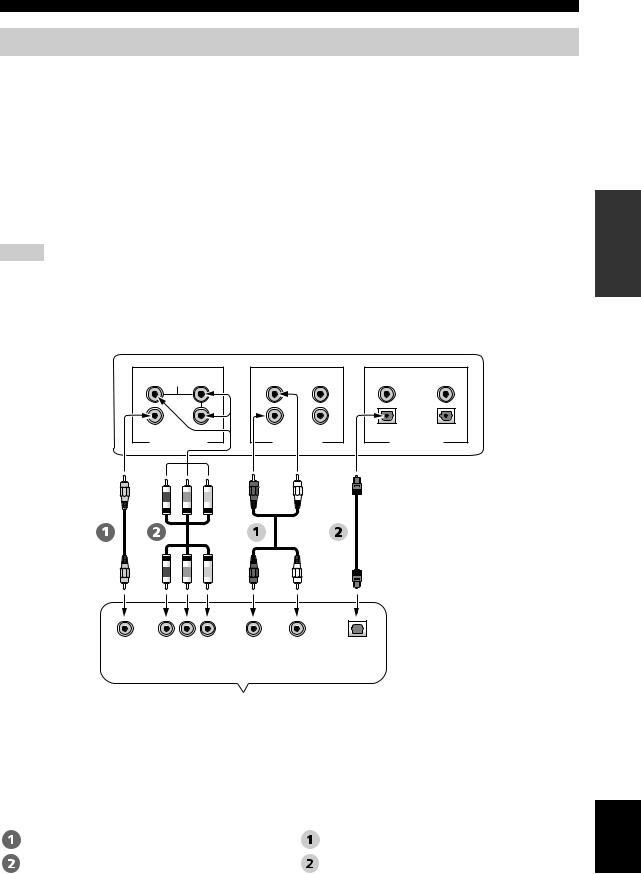
Connections
Connecting a TV
For audio connection, connect the analog audio output jacks on your TV to the TV/STB AUDIO IN jacks on this unit. If your TV has an optical digital output jack, connect the optical digital output jack on your TV to the TV/STB OPTICAL DIGITAL IN jack on this unit.
For video connection, connect the video input jack on your TV to the VIDEO OUT jack on this unit to display the OSD for easy viewing when you adjust the system parameters in SET MENU. If your TV has component video input jacks, connect the component video input jacks of your TV to the COMPONENT VIDEO OUT jacks of this unit in addition to the composite video connection. Once the component video connection is made, you can enjoy images with better resolution.
y
To prevent the optical cable from being unplugged, affix the optical cable in the supplied cable clamp (see page 21).
Notes
•If you make analog and optical digital audio connections at the same time as shown in the illustration below, the digital audio signals input at the TV/STB OPTICAL DIGITAL IN jack take priority over the analog audio signals input at the TV/STB AUDIO IN jacks.
•Even if you connect your TV and this unit via the HDMI jack, you need to connect the video input jack on your TV to the VIDEO OUT jack on this unit in order to display the OSD of this unit.
|
|
|
Rear panel of this unit |
|
COMPONENT |
|
|
DVD |
AUX 2 |
|
|
|
COAXIAL |
|
|
|
|
OPTICAL |
|
VIDEO OUT |
TV/STB |
AUX 1 |
TV/STB |
AUX 1 |
AUDIO IN |
DIGITAL IN |
|||
PREPARATION
|
R |
L |
|
Video |
Component |
Analog |
Optical |
input |
video input |
audio |
digital |
|
|
output |
output |
|
|
|
|
|
|
|
|
|
|
|
|
|
|
|
|
|
|
|
|
|
|
|
|
|
|
|
|
|
|
|
|
|
|
|
|
|
|
|
|
|
|
|
|
|
|
|
|
|
|
|
|
|
|
|
|
|
|
|
|
TV |
|||||
|
|
|
|
|
|
|
|
|||
Video |
|
|
|
|
|
|
Audio |
|||
OSD video pin cable |
|
|
|
|
|
|
Audio pin cable |
|||
Component video pin cable |
|
|
|
|
|
|
Optical cable |
|||
English
23 En
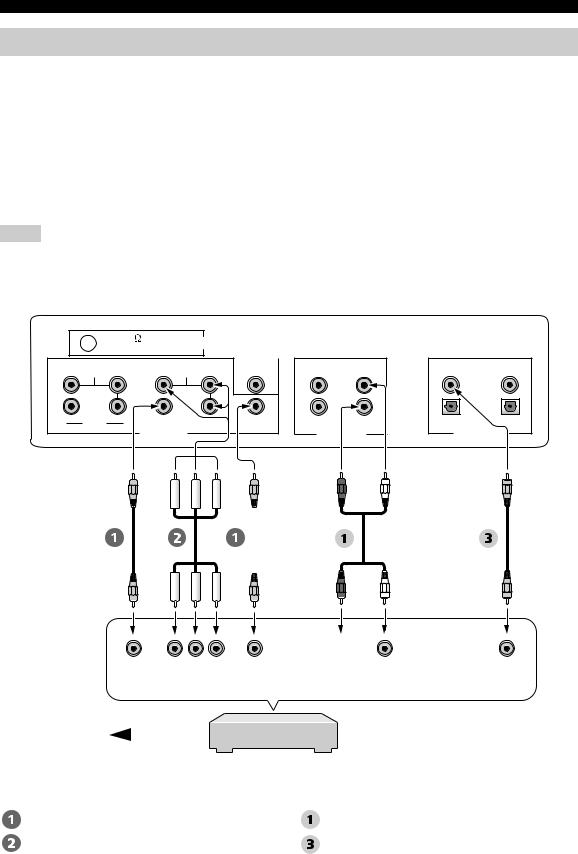
Connections
Connecting a DVD player/recorder
For audio connection, connect the coaxial digital output jack on your DVD player/recorder to the DVD COAXIAL DIGITAL IN jack on this unit. When you connect this unit to your DVD/VCR combo player/recorder, connect the analog audio output jacks on your DVD/VCR combo player/recorder to the AUX 1 AUDIO IN jacks on this unit in addition to the coaxial digital audio connection.
For video connection, connect the video output jack of your DVD player/recorder to the DVD/AUX 2 VIDEO IN jack of this unit. If your DVD player/recorder has component video output jacks, connect the component video output jacks of your DVD player/recorder to the DVD/AUX 2 COMPONENT VIDEO IN jacks of this unit. Once the component video connection is made, you can enjoy images with better resolution.
y
To prevent the optical cable from being unplugged, affix the optical cable in the supplied cable clamp (see page 21).
Notes
•Check that your DVD player/recorder is properly set to output Dolby Digital and DTS digital audio signals. If not, adjust the system settings of your DVD player/recorder. For details, refer to the operation manual supplied with your DVD player/recorder.
•If your DVD player/recorder does not have a coaxial digital output jack, make an optical digital audio connection instead (see page 28).
FM75 |
|
|
|
|
|
Rear panel of this unit |
|
|
ANTENNA |
|
|
|
|
|
|
UNBAL. |
|
|
|
|
|
||
|
SUBWOOFER |
|
|
|
|
||
COMPONENT |
|
COMPONENT |
|
|
DVD |
AUX 2 |
|
|
|
|
|
||||
|
|
|
|
|
|
COAXIAL |
|
|
|
|
|
|
|
OPTICAL |
|
STB |
|
DVD/AUX 2 |
AUX 1 |
TV/STB |
AUX 1 |
TV/STB |
AUX 1 |
|
VIDEO IN |
|
AUDIO IN |
DIGITAL IN |
|||
*1You can only make |
|
|
|
|
|
|
|
|
|
|
|
|
|
|
|
|
|
|
|
|
|
|
|
|
|
|
*2For the DVD/ |
|
|
|
|
|
|
|
|
|
|
|
|
|
|
|
|
|
|
||
|
|
|
|
|
|
|
|
|
|
|
*2 |
||||
|
|
|
|
|
|
|
|
|
|
|
|||||
|
|
|
|
|
|
|
|
|
|
|
|||||
|
|
|
|
|
|
|
|
|
|
|
|||||
|
|
|
|
|
|
|
|
|
|
|
|||||
*1 |
|
|
*1 |
|
|
*2 |
|
|
|||||||
either a composite |
|
|
|
|
|
|
VCR combo |
||||||||
|
|
|
|
|
|
|
|
|
|
|
|
|
|
||
or a component |
|
|
|
|
|
|
|
|
|
|
|
player/recorder |
|
|
|
connection. |
|
|
|
|
|
|
|
|
|
|
|
connection |
|
|
|
|
|
|
|
|
|
|
|
|
|
|
|
|
|
|
|
|
|
|
|
|
|
|
|
|
|
|
|
|
|
|
|
|
|
|
|
|
|
|
|
|
|
|
|
|
|
|
|
|
|
|
|
|
|
|
|
|
|
|
|
|
|
|
|
|
|
|
|
|
|
|
|
|
|
|
|
|
|
|
|
|
|
|
|
|
|
|
|
|
|
|
|
|
|
|
|
|
|
|
|
|
|
|
|
|
|
|
|
|
|
|
|
|
|
|
|
|
|
|
|
|
|
|
|
|
|
|
|
|
|
|
|
|
|
|
|
|
|
|
|
|
|
|
|
|
|
|
|
|
|
|
|
|
|
|
|
|
|
|
|
R  L
L
Video |
Component |
Video |
|
|
Analog |
Coaxial |
|||
output |
video output |
output |
|
|
audio |
digital |
|||
|
|
|
|
|
|
|
|
output |
output |
|
|
|
|
|
|
|
|
|
|
|
|
|
|
|
|
|
|
|
|
|
|
|
|
|
|
|
|
|
|
|
|
|
|
|
|
|
|
|
|
|
|
|
|
|
|
|
|
|
|
Video signal to the TV |
DVD player/recorder |
||
|
|
|
|
Video |
|
|
Audio |
Video pin cable |
|
|
Audio pin cable |
Component video pin cable |
|
|
Digital audio pin cable |
24 En

Connections
Connecting a digital satellite tuner or a cable TV tuner
For audio connection, connect the optical digital output jack on your digital satellite tuner or cable TV tuner to the TV/ STB OPTICAL DIGITAL IN jack on this unit. Connect the analog audio output jacks on your digital satellite tuner or cable TV tuner to the TV/STB AUDIO IN jacks on this unit.
For video connection, connect the video output jack of your digital satellite tuner or cable TV tuner to the STB VIDEO IN jack of this unit. If your digital satellite tuner or cable TV tuner has component video output jacks, connect the component video output jacks of your digital satellite tuner or cable TV tuner to the STB COMPONENT VIDEO IN jacks of this unit. Once the component video connection is made, you can enjoy images with better resolution.
y
To prevent the optical cable from being unplugged, affix the optical cable in the supplied cable clamp (see page 21).
|
|
|
|
|
|
Rear panel of this unit |
|
FM75 |
|
ANTENNA |
|
|
|
|
|
UNBAL. |
|
|
|
|
|
||
|
SUBWOOFER |
|
|
|
|
||
COMPONENT |
|
COMPONENT |
|
|
DVD |
AUX 2 |
|
|
|
|
|
||||
|
|
|
|
|
|
COAXIAL |
|
|
|
|
|
|
|
OPTICAL |
|
STB |
|
DVD/AUX 2 |
AUX 1 |
TV/STB |
AUX 1 |
TV/STB |
AUX 1 |
|
VIDEO IN |
|
AUDIO IN |
DIGITAL IN |
|||
PREPARATION
|
|
|
|
|
|
|
|
|
|
|
|
|
|
|
|
|
|
|
|
|
|
|
|
|
|
|
|
|
|
|
|
|
|
|
|
|
|
|
|
|
|
|
|
|
|
|
|
|
|
|
|
|
|
|
|
|
|
|
|
|
|
|
|
|
|
|
|
|
|
|
|
|
|
|
|
|
|
|
|
|
* |
|
|
* |
|
|
|
* You can only make |
|
|
|
|
|
|
|
|
|
either a composite |
|
|
|
|
|
|
|
|
or a component |
|
|
|
|
|
|
|
|
connection. |
|
|
|
|
|
|
|
|
|
|
|
|
|
|
|
|
|
|
|
|
|
|
|
|
|
|
|
|
|
|
|
|
|
|
|
|
|
|
|
|
|
|
|
|
|
|
|
|
|
|
|
|
|
|
|
|
|
|
|
|
|
|
|
|
|
|
|
|
|
|
|
|
|
R |
L |
|
Video |
Component |
Analog |
Optical |
output |
video output |
audio |
digital |
|
|
output |
output |
|
|
|
|
|
|
|
|
|
|
|
|
|
|
|
|
|
|
|
|
|
|
|
|
|
|
|
|
|
|
|
|
|
|
|
|
|
|
|
|
|
|
|
|
Video signal to the TV |
Digital satellite tuner |
|||||||||
* This connection (except for a game console) is not |
or cable TV tuner |
|||||||||
|
|
|
|
|
|
|
|
|||
necessary if your TV has a built-in digital satellite |
|
|
|
|
|
|
|
|
||
tuner, cable TV tuner, or digital airwave tuner. |
|
|
|
|
|
|
|
|
||
|
|
|
|
|
|
|
|
|
||
Video |
|
|
|
|
|
|
|
Audio |
||
Video pin cable |
|
|
|
|
|
|
Audio pin cable |
|||
Component video pin cable |
|
|
|
|
|
|
Optical cable |
|||
English
25 En
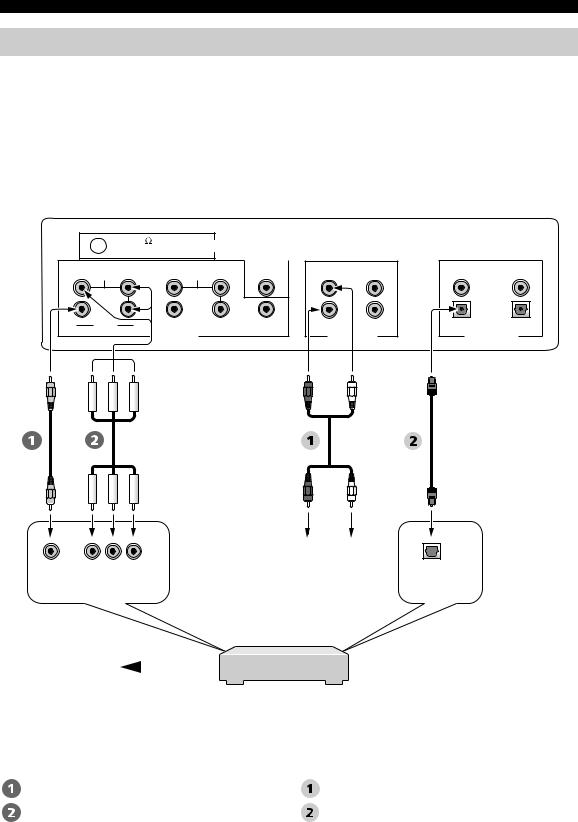
Connections
Connecting a digital airwave tuner
For audio connection, connect the TV/STB AUDIO IN jacks on this unit to the analog audio output jacks on your TV. Connect the optical digital output jack on your digital airwave tuner to the TV/STB OPTICAL DIGITAL IN jack on this unit in addition to the analog audio connection. By doing so, you can enjoy both analog and digital broadcasts.
For video connection, connect the video output jack of your digital airwave tuner to the STB VIDEO IN jack of this unit. If your digital airwave tuner has component video output jacks, connect the component video output jacks of your digital airwave tuner to the STB COMPONENT VIDEO IN jacks of this unit. Once the component video connection is made, you can enjoy images with better resolution.
y
To prevent the optical cable from being unplugged, affix the optical cable in the supplied cable clamp (see page 21).
FM75 |
|
|
|
|
|
Rear panel of this unit |
|
|
ANTENNA |
|
|
|
|
|
|
UNBAL. |
|
|
|
|
|
||
|
SUBWOOFER |
|
|
|
|
||
COMPONENT |
|
COMPONENT |
|
|
DVD |
AUX 2 |
|
|
|
|
|
||||
|
|
|
|
|
|
COAXIAL |
|
|
|
|
|
|
|
OPTICAL |
|
STB |
|
DVD/AUX 2 |
AUX 1 |
TV/STB |
AUX 1 |
TV/STB |
AUX 1 |
|
VIDEO IN |
|
AUDIO IN |
DIGITAL IN |
|||
|
|
|
|
|
|
|
|
* You can only make |
|
|
|
|
|
|
|
|
|
|
|
|
|
|
|
|
|
|
|
|
|
|
|
|
|
|
|
|
|
|
|
|
|
|
|
|
|
|
|
|
|
|
|
|
|
|
|
|
|
|
|
|
|
|
|
|
|
|
|
|
|
|
|
|
|
|
|
|
|
|
|
|
* |
|
|
* |
|
|
|
||
|
|
|
|
|
|
|
|
either a composite |
|
|
|
|
|
|
|
|
or a component |
|
|
|
|
|
|
|
|
connection. |
|
|
|
|
|
|
|
|
|
|
|
|
|
|
|
|
|
|
|
|
|
|
|
|
|
|
|
|
|
|
|
|
|
|
|
|
|
|
|
|
|
|
|
|
|
|
|
|
|
|
|
|
|
|
|
|
|
|
|
|
|
|
|
|
|
|
|
|
|
|
|
|
|
|
|
|
|
|
|
|
|
|
|
|
|
|
|
|
|
|
Video |
Component |
output |
video output |
Connect to the analog audio output jacks on
the TV. Optical digital output
|
|
|
|
|
|
|
|
|
|
|
|
|
|
|
|
|
|
|
|
|
|
|
|
|
|
|
|
|
|
|
|
Video signal to the TV |
Digital airwave tuner |
||||||
*This connection (except for a game console) is not necessary if your TV has a built-in digital satellite tuner, cable TV tuner, or digital airwave tuner.
Video |
|
Audio |
Video pin cable |
|
Audio pin cable |
Component video pin cable |
|
Optical cable |
26 En
